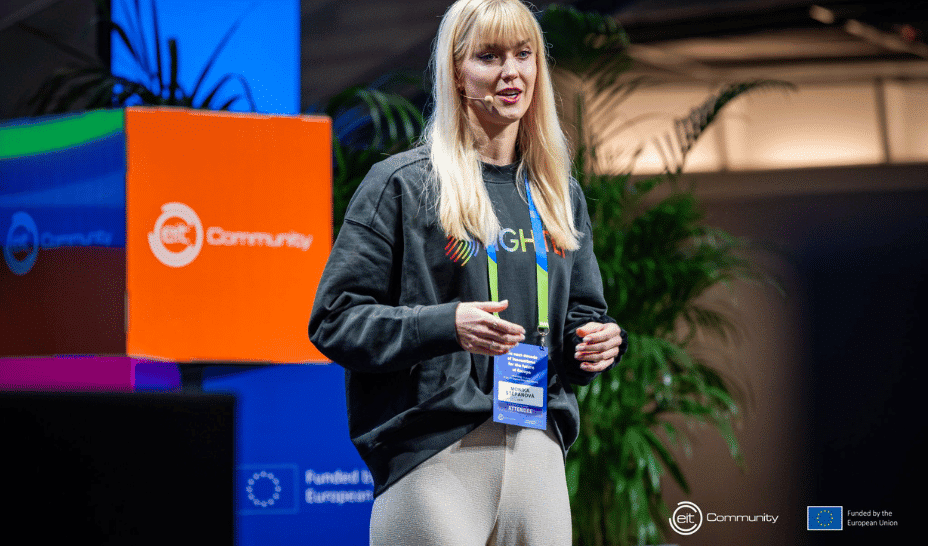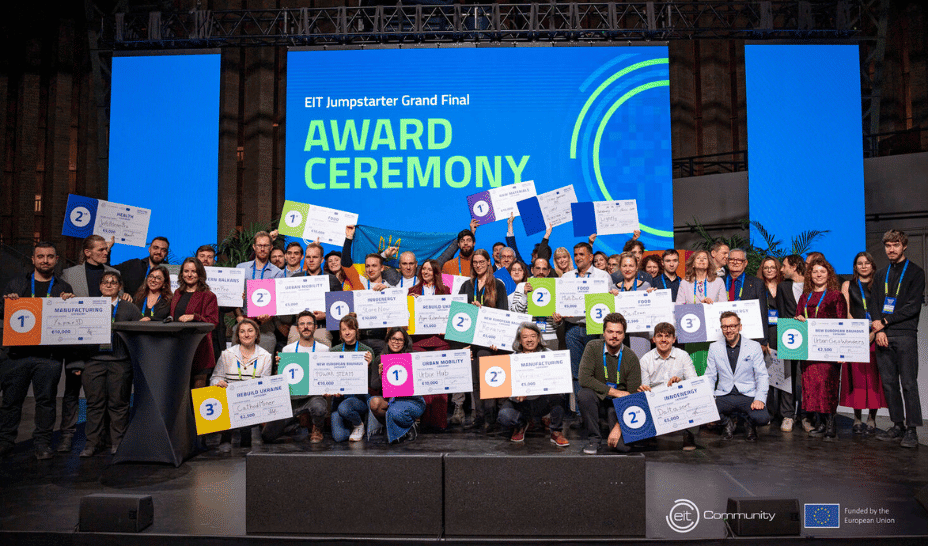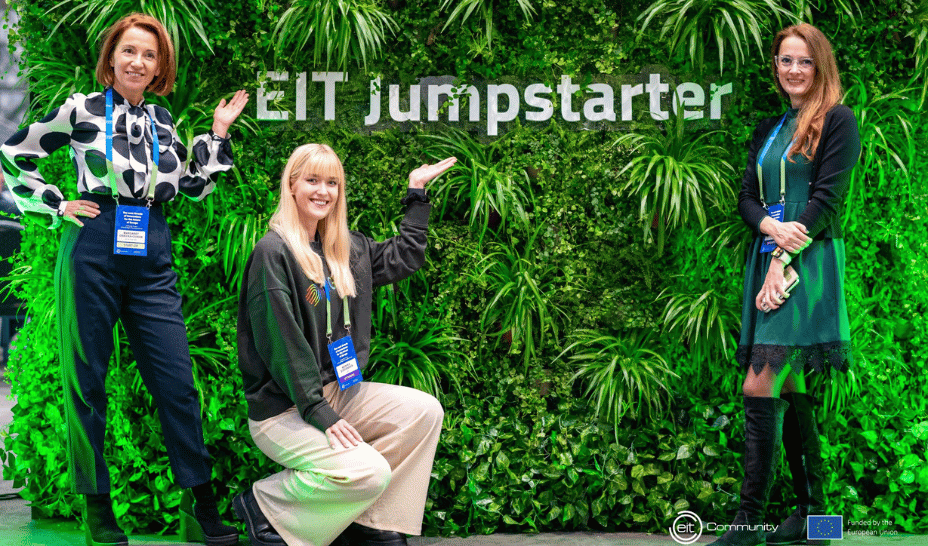Editors note: This partnership article is part of a “PR Pack” reward by EU-Startups, Enterie PR network and Profeina PR agency.
EIT Jumpstarter, a leading pre-acceleration program by the European Institute of Innovation and Technology (EIT), helps early-stage innovators turn ideas into startups through mentorship, business validation, and funding. Since its launch, it has trained over 1,180 entrepreneurs, supported 124 startups, and facilitated €150 million in funding, while providing access to a vast network of experts and investors across Europe.
The Jumpstarter Grand Final is the culmination of this program, where top startups pitch their ideas after months of intensive training. This year, the initiative is expanding support for talent from Ukraine, the Western Balkans, the Mediterranean, and the EU’s outermost regions. Registration for the 2025 edition is already open!
Today, we will dive into one of the many success stories of this programme—Lightly, a deep-tech startup that is revolutionising counterfeit drug detection. They developed Catcher, a portable detection device that enables law enforcement to identify counterfeit medicines in real time and trace their origins using a patented UV-Fingerprint method. Their innovation earned them second place in the EIT Health category in 2023, followed by a win in Post-Jumpstarter 2024, further validating their impact.
In this interview, Monika Štěpánová, CEO & Co-founder of Lightly, shares insights into their journey, from early challenges to technological breakthroughs and their ambitious plans to redefine counterfeit drug detection for police units, forensic teams, and beyond. Let’s dive right into it!
Story, technology, and impact

What motivated you to create Lightly and focus on combating counterfeit medicines? Was there a specific event or insight that sparked the idea?
Lightly was born from our team’s diverse backgrounds and a shared commitment to addressing global challenges. We met at the Department of Chemistry and Biochemistry at Mendel University in Brno, where scientists and a business and economics student collaborated on real-world problems.
Initially, our focus was on analyzing water and detecting counterfeit wine using advanced analytical methods. However, in 2019, before Lightly was even founded, the police approached us after recognizing the potential of our technology. They took us on a mission to the United States, where we visited the DEA and Interpol. There, we saw firsthand the devastating impact of the opioid crisis. Witnessing its scale and human toll gave us a clear sense of purpose.
We couldn’t stand by and let technology with such potential sit on a shelf in a lab. We felt a responsibility to apply our knowledge in a way that could make a real difference. From that moment, we dedicated ourselves to fighting counterfeit drugs, particularly those fueling the opioid crisis. Our mission became clear: to equip law enforcement with the tools to detect counterfeit medicines quickly and trace them to their source. This journey, driven by collaboration and the belief that innovation must be applied where it matters most, continues to guide us.
What is Catcher? Can you share more about how this idea evolved and how you incorporated the single-use cartridges, Fenty, into the solution?
Catcher is a portable device designed to help police identify counterfeit medicines on the spot and trace their origins. It uses a patented “UV-Fingerprint” method to analyze samples, creating a unique chemical profile for precise identification. Results are available in under 10 minutes and are automatically uploaded to a global database, enabling the cross-matching of individual cases—something no other solution on the market offers.
The global counterfeit drug crisis fuels a $200 billion illegal market, with fake medicines causing at least 250,000 deaths annually. The opioid epidemic alone accounts for 600,000 drug-related deaths worldwide, driven by fentanyl, which is 50 times stronger than heroin, and found in 7 out of 10 counterfeit pills. Meanwhile, the drug screening market, valued at €8 billion, is projected to grow to €20 billion by 2030, yet current solutions are either slow lab tests or basic field kits—this is where Catcher stands out.
We plan to scale Catcher beyond law enforcement by expanding into government agencies, border control, private security, and pharmacies, targeting key organizations like DOGE and similar agencies to enhance drug enforcement efficiency. With a hardware + consumables model, our revenue comes from device sales, recurring cartridge usage and a global database, ensuring predictable growth.
How does Catcher work in combination with Fenty cartridges, and what makes it particularly effective in identifying counterfeit medicines?
Catcher and Fenty cartridges work together through a simple three-step process designed for ease of use and high accuracy:
- Insert the sample into the single-use Fenty cartridge: The cartridge ensures standardized sample preparation, making the process easy and reliable, even for non-experts.
- Place the cartridge into the Catcher device: The device uses patented “UV-Fingerprint” technology to analyze the chemical composition of the sample, generating a unique profile.
- Receive immediate results: Within minutes, the device evaluates the sample and compares it to a global database, identifying counterfeit medicines and cross-matching cases to trace their origins.
This streamlined process makes Catcher particularly effective. By combining precise chemical profiling, real-time database integration, and case cross-matching, it enables law enforcement to quickly uncover and connect related cases, a crucial advantage in the fight against counterfeit drugs.
Can you elaborate on how your software and global database contribute to the fight against counterfeit drugs and the tracking of dangerous substances?
Every sample analyzed by Catcher is automatically uploaded, creating a centralized hub of chemical profiles that enables real-time data access and comparison. The database goes beyond identifying counterfeit drugs—it cross-matches chemical fingerprints, linking cases to help law enforcement uncover patterns, trace sources, and connect shipments to manufacturers.
As the database grows, AI integration enhances pattern recognition, detecting subtle similarities between cases. This network effect strengthens over time, making analysis faster, smarter, and more accurate.
About the EIT Jumpstarter Program

How did you first hear about the EIT Jumpstarter programme, and why did you decide to apply?
I first discovered the programme on LinkedIn and was immediately intrigued. At the time, we were in the early stages of developing Lightly, and the programme seemed like the perfect fit. Its focus on supporting early-stage innovations and helping startups refine their ideas aligned perfectly with our needs.
From the beginning, we thought globally rather than limiting ourselves to Czech opportunities. Our goal was always to create a solution with international impact, so the programme’s pan-European scope and cross-border innovation support resonated with us. It provided an opportunity not just to validate our idea but also to lay the groundwork for global scaling.
Being the winner of the EIT Jumpstarter Grand Finale is a remarkable milestone. How did the programme support you in refining your technology and business model?
Winning was a major milestone for us, giving us a deeper understanding of how to align our technology with market needs and investor expectations. The programme helped us sharpen our value proposition, improve communication with stakeholders, and develop a clear go-to-market strategy. It also guided us in identifying the most promising markets and refining our commercialisation approach.
The networking opportunities were invaluable. Connecting with mentors and peers across Europe provided insights into scaling deep-tech innovations, navigating regulations, and forming partnerships. It also pushed us to think critically about scalability, global impact, and long-term sustainability.
Winning the “Most Outstanding Alumni Award” highlighted how far we’ve come. It reinforced our commitment to achieving our goals and making a real impact while strengthening our sense of responsibility as part of the EIT community.
Were there any specific insights, mentorship, or connections gained during the EIT Jumpstarter programme that were instrumental to your progress?
Oh yes! Definitely. The network we built through the EIT Jumpstarter programme was invaluable. I’d especially like to acknowledge the incredible support and inspiration from Piotr Boulange, Marta Kaczmarek, Maks Stempniewicz, and the many founders we met along the way. The mentorship and connections went beyond professional guidance—they helped us see new possibilities, refine our approach, and stay motivated during challenges.
What stood out the most was the sense of community. We didn’t just build professional relationships; we formed strong friendships that became a source of constant support. Having people who truly understand your journey, celebrate your wins, and encourage you through setbacks makes all the difference. The EIT Jumpstarter experience wasn’t just about business—it became a cornerstone for both our professional and personal growth.
Challenges and Obstacles

What were some of the biggest technical or logistical challenges you faced in developing Catcher and Fenty?
There were many, but one of the biggest technical challenges was miniaturizing the patented “UV-Fingerprint” technology into a portable, field-ready device without compromising accuracy or performance. Delivering laboratory-quality results in under 10 minutes required extensive research, prototyping, and testing. Also Developing the Fenty cartridges. We needed to create single-use cartridges that standardized sample preparation, making the device easy to use for non-experts, while keeping costs manageable.
As a deep-tech company, development came with inherently high costs. Translating a university-developed technology into a commercially viable product requires significant investment in technology transfer, licensing, and intellectual property protection. Scaling such an advanced technology also meant building specialized expertise and infrastructure to ensure reliability in real-world conditions.
How did you ensure your device meets the needs of police units and other stakeholders during its development?
We worked closely with stakeholders throughout the development process, collaborating with police units, forensic experts, and law enforcement agencies like the DEA, Interpol, and the Sheriff’s Office of Huntsville, Alabama. Their feedback helped us tailor Catcher to their specific needs.
Portability, ease of use, and speed were top priorities to ensure the device could function effectively in the field. By involving stakeholders in real-world testing and refining prototypes based on their input, we made sure that Catcher and Fenty cartridges were user-friendly, highly accurate, and capable of delivering on-the-spot results. Additionally, our software’s ability to cross-match cases and analyze patterns in a global database was designed in response to law enforcement’s need for better case connectivity.
Our partnerships with the Czech police and international agencies continue to provide valuable insights, ensuring our solution remains aligned with the challenges of combating counterfeit drugs and effectively supporting law enforcement efforts.
Future Prospects and Vision

What are the next steps for Lightly? Are there plans to expand its applications beyond counterfeit medicine detection?
Our immediate focus is on finalizing the development of Catcher and Fenty cartridges, scaling production, and expanding into key markets such as the U.S., Europe, and the Middle East. We plan to conduct large-scale testing with law enforcement agencies, including the DEA, Interpol, and the Sheriff’s Office in Huntsville, Alabama, to refine and validate our solution in real-world conditions.
Beyond counterfeit medicine detection, we aim to expand our technology into other sectors. In the longer term, we also plan to develop miniaturized versions of our device and explore partnerships in industries like agriculture, food safety, and environmental monitoring. This diversification aligns with our mission to make the world a safer, healthier, and more sustainable place while leveraging the full potential of our technology.
How do you plan to scale your solution and make it accessible to more police units and other relevant stakeholders globally?
By focusing on production, partnerships, and strategic global expansion. We are optimizing the manufacturing process for Catcher and Fenty cartridges to ensure consistent quality and affordability, allowing us to meet the growing demand from police units and other stakeholders worldwide.
Our primary target markets include the U.S., Europe, and the Middle East, where we are adapting our approach to fit each region’s regulatory landscape, budget constraints, and enforcement priorities. To ensure accessibility, we are also considering flexible payment models, such as subscription-based pricing, to accommodate departments with limited budgets.
Our global database and AI-driven software are key to scaling. As more data is collected, the network effect strengthens, enhancing the system’s ability to identify counterfeit drugs and track supply chains more effectively, making it an even more valuable tool for law enforcement worldwide.
Looking five years ahead, what is your vision for Lightly and the broader impact you hope to achieve with Catcher and its related technologies?
In five years, we aim for Lightly to be a global leader in counterfeit detection, with Catcher widely adopted by law enforcement, border control, and forensic teams. We plan to expand its applications beyond counterfeit medicine detection to areas like border security, airport screening, water quality testing, and environmental monitoring.
Our goal is to equip authorities with fast, reliable substance detection tools to prevent dangerous substances like fentanyl from entering communities. A key priority is strengthening collaborations with international agencies and expanding our global database, making it a powerful tool for tracking illicit drug networks.
We also see potential in partnering with government agencies like DOGE in the U.S., aligning our technology with public safety initiatives. As we scale, we aim to set a new industry standard in rapid, portable detection, ensuring a safer and more secure future.


